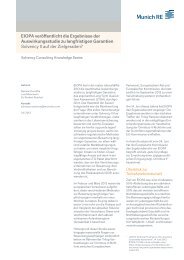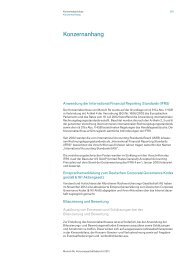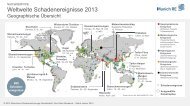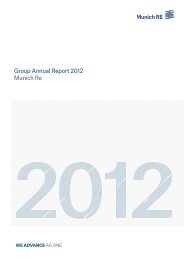Munich Re Group Annual Report 2006 (PDF, 1.8
Munich Re Group Annual Report 2006 (PDF, 1.8
Munich Re Group Annual Report 2006 (PDF, 1.8
You also want an ePaper? Increase the reach of your titles
YUMPU automatically turns print PDFs into web optimized ePapers that Google loves.
<strong>Munich</strong> <strong>Re</strong> <strong>Group</strong> <strong>Annual</strong> <strong>Re</strong>port <strong>2006</strong> Notes_Disclosures on the uncertainties of future cash flows from insurance contracts<br />
Risk minimisation measures<br />
In reinsurance, biometric risks are controlled by means of a risk-adequate<br />
underwriting policy. Risks are restricted through appropriate<br />
treaty design, specifically by limiting the coverage in the case of nonproportional<br />
business. In particular, the underwriting of longevity<br />
risks from reinsured portfolios is strictly limited. Interest-rate and<br />
other market risks are frequently ruled out by depositing the provisions<br />
with the cedant, with a guaranteed rate of interest from the<br />
deposit. In individual cases, these risks are also hedged by means<br />
of suitable capital market instruments.<br />
In primary insurance, there is substantial risk minimisation<br />
through product design. For the most part, prudent actuarial<br />
assumptions are used in fixing the guaranteed benefits, in addition<br />
to which policyholders are granted a performance-related participation<br />
in surplus. More than 99% of the amount shown under (20) “Provision<br />
for future policy benefits” is apportionable to such contracts.<br />
Given the relevant margins in the actuarial assumptions, it is also<br />
possible to fulfil the future guaranteed obligations without adjusting<br />
the provisions in the case of moderate changes in assumptions. In<br />
addition, the provision for deferred premium refunds and portions of<br />
the provision for premium refunds based on national regulations,<br />
shown under (22) “Other technical provisions”, is of great significance<br />
for risk-balancing in the case of adverse developments. In<br />
health primary insurance, substantial risk minimisation is also provided<br />
for by the premium adjustment clause underlying most longterm<br />
contracts.<br />
Impact on equity and the consolidated income statement<br />
In the liability adequacy test pursuant to IFRS 4, we regularly test the<br />
technical provisions and deferred acquisition costs to ensure they<br />
are appropriate. An adjustment is made if such tests show that the<br />
original provisions for adverse deviation allowed for in the biometric<br />
actuarial assumptions, or in the assumptions for discounting provisions<br />
and for lapses, have been exhausted. Particularly in primary<br />
insurance, the possibilities of adjusting participation in surplus are<br />
taken into account.<br />
If an adjustment is required, we recognise any deficit as an<br />
expense in the consolidated income statement.<br />
(37) Risks from insurance contracts in the property-casualty<br />
segment<br />
Of particular importance in this segment is the estimation risk with<br />
regard to the amount of the expected claims expenditure for future<br />
claims from current insurance contracts (premium risk) and for<br />
claims already incurred (reserve risk). In estimating claims expenditure,<br />
we also take cost increases into account. Besides this, there is<br />
an interest-rate risk for parts of the portfolio.<br />
The basis for measuring the risk assumed is an estimate of the<br />
claims frequency to be expected for a portfolio of contracts. In addition,<br />
an estimation of the claims amount is necessary, from which a<br />
mathematical distribution of the expected losses is derived. The<br />
result of these two steps is an estimation of the expected overall<br />
claims in a portfolio. A third element comprises the expected cash<br />
flows to settle claims incurred, a process which frequently extends<br />
over several years.<br />
Premium risks<br />
The degree of exposure to estimation risks differs according to class<br />
of business and also between primary insurance and reinsurance.<br />
On the basis of the loss ratios and combined ratios of recent years,<br />
conclusions can be drawn about the historical volatilities in the different<br />
classes of business and about possible interdependencies.<br />
The differences in volatility are due equally to fluctuations in claims<br />
burdens and fluctuations in the respective market price level for the<br />
covers granted.<br />
203

















